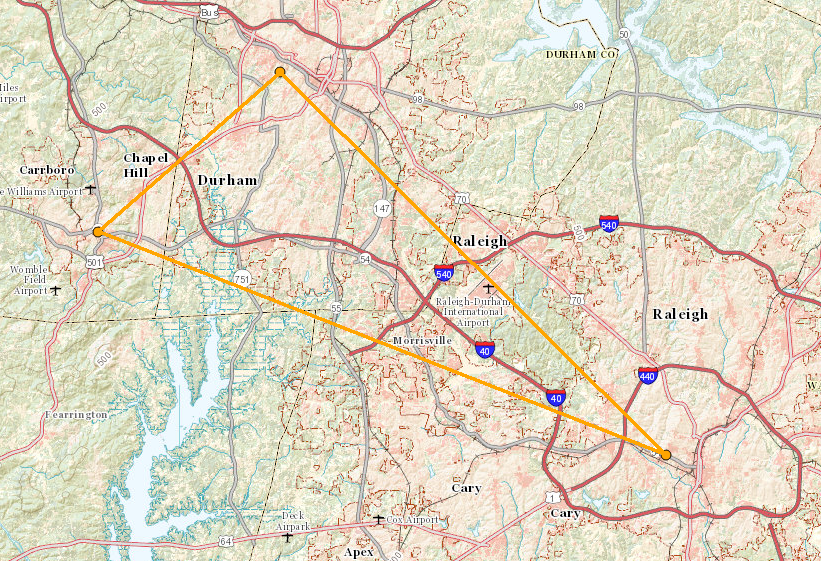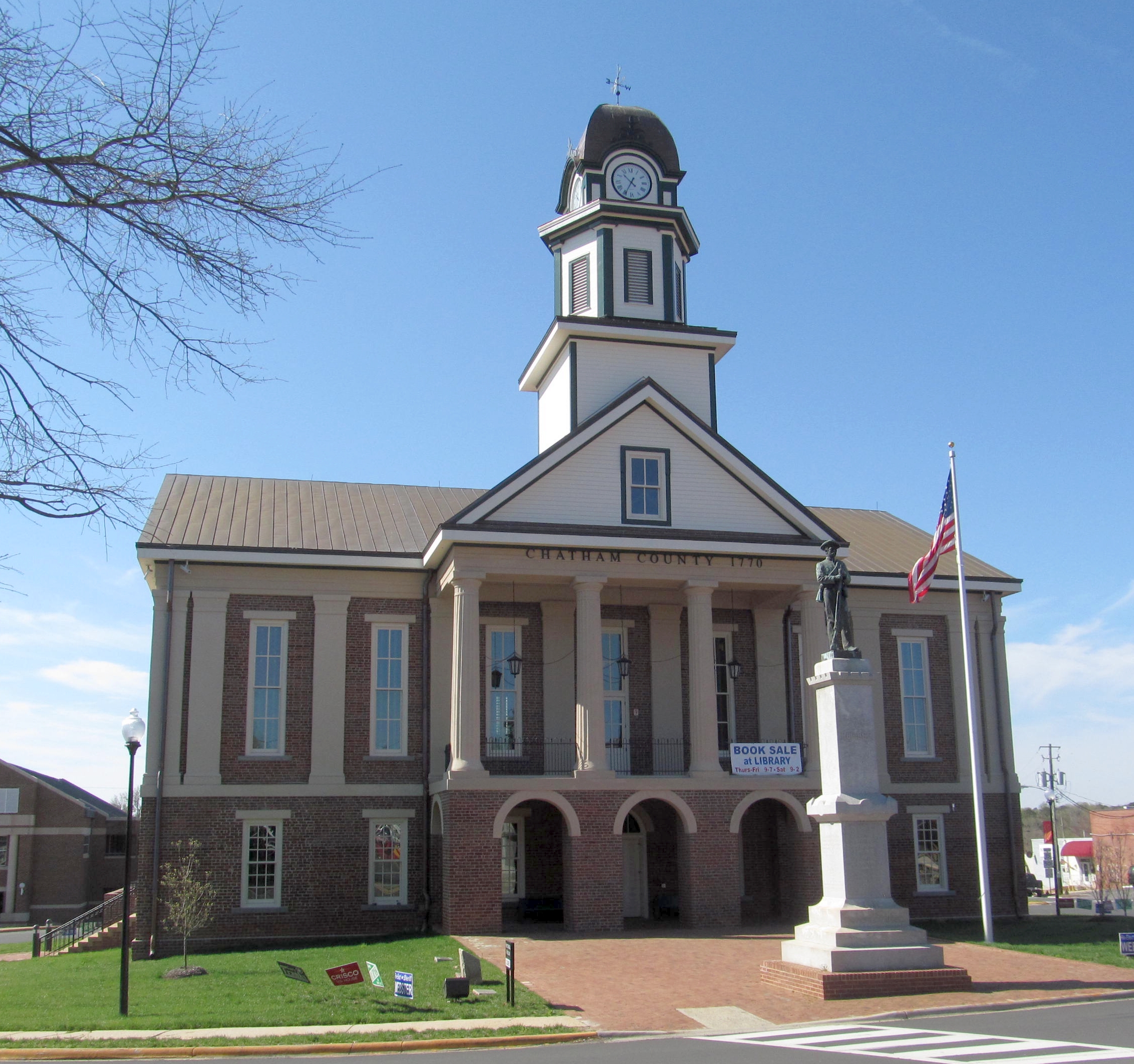|
New Hope River Valley
The New Hope Valley is located in the heart of The Triangle (North Carolina). The valley has been the site of a broad range of cultures for more than 10,000 years. Archaeologists have explored the remains of 450 prehistoric and historic sites in the area and have uncovered many Native American artifacts. The area was first explored by Europeans in 1701, and by 1810 a network of farms dotted the valley linked to Pittsboro, North Carolina, the county seat. The land was settled by Scottish Highlanders in the 1740s, and it saw action in both the Revolutionary and Civil wars. It became a logging center in the early 1900s as railroads such as the New Hope Valley Railway pushed through the area. Following a disastrous hurricane which struck the Cape Fear River Basin in 1945, Congress directed the U.S. Army Corps of Engineers to undertake a comprehensive study of water resource needs in the area. The project, then known as New Hope Lake, was authorized in 1963, and construction began i ... [...More Info...] [...Related Items...] OR: [Wikipedia] [Google] [Baidu] |
The Triangle (North Carolina)
The Research Triangle, or simply The Triangle, are both common nicknames for a metropolitan area in the Piedmont region of North Carolina in the United States, anchored by the cities of Raleigh and Durham and the town of Chapel Hill, home to three major research universities: North Carolina State University, Duke University, and University of North Carolina at Chapel Hill, respectively. The nine-county region, officially named the Raleigh–Durham–Cary combined statistical area (CSA), comprises the Raleigh–Cary and Durham–Chapel Hill Metropolitan Statistical Areas and the Henderson Micropolitan Statistical Area. The "Triangle" name originated in the 1950s with the creation of Research Triangle Park, located between the three anchor cities and home to numerous high tech companies. A 2019 Census estimate put the population at 2,079,687, making it the second largest combined statistical area in the state of North Carolina behind Charlotte CSA. The Raleigh–Durham televi ... [...More Info...] [...Related Items...] OR: [Wikipedia] [Google] [Baidu] |
Pittsboro, North Carolina
Pittsboro is a town in Chatham County, North Carolina, United States. The population was 3,743 at the 2010 census and 4,537 at the 2020 census. It is the county seat of Chatham County. The town was established in the late 18th century, shortly after the American Revolution, as the county seat for the newly formed Chatham County. In the years leading up to the United States civil war, the economy was dominated by small-scale farms that relied heavily on slave labor, and in the aftermath of the civil war, racial tensions were high, and the town was noted for a number of lynchings and other racial violence in the late 19th century. Industrialization came to the community in the 19th century, as a number of rivers cross the area providing locations for mills and factories. As industry moved away from the community, it has in the 21st century transitioned into a bedroom community for the nearby cities of the Research Triangle region. History Foundation and early years Pittsbor ... [...More Info...] [...Related Items...] OR: [Wikipedia] [Google] [Baidu] |
New Hope Valley Railway
The New Hope Valley Railway is a heritage railroad in Bonsal, North Carolina operated by the North Carolina Railway Museum, Inc., an all-volunteer, nonprofit, and tax exempt educational and historical organization. The railroad consists of a total of 5 miles of track between the communities of Bonsal, North Carolina and New Hill, North Carolina. The North Carolina Railway Museum, located in Bonsal, North Carolina, features a collection of antique train cars, artifacts and historic train memorabilia, and a G-scale model railroad layout and club. Excursion trains The railroad operates passenger excursion trains each month from April to December. Special trains are operated for Halloween on the evening of the last three Saturdays in October. They have many other themed train excursions throughout the year. Operate-a-Loco The New Hope Valley Railway has many different special activities that people can participate in. One of them is their Operate-a-Loco program. On select Saturda ... [...More Info...] [...Related Items...] OR: [Wikipedia] [Google] [Baidu] |
1945 Southeast Florida Hurricane
The 1945 Homestead hurricane was the most intense tropical cyclone to strike the U.S. state of Florida since 1935. The ninth tropical storm, third hurricane, and third major hurricane of the season, it developed east-northeast of the Leeward Islands on September 12. Moving briskly west-northwestward, the storm became a major hurricane on September 13. The system moved over the Turks and Caicos Islands the following day and then Andros on September 15. Later that day, the storm peaked as a Category 4 hurricane on the modern-day Saffir–Simpson hurricane wind scale with winds of 130 mph (215 km/h). Late on September 15, the hurricane made landfall on Key Largo and then in southern Miami-Dade County, and across Homestead, FL where much damage was done and winds were clocked at Homestead Army Air Corps Base at 145 mph. Thereafter, the hurricane began to weaken while moving across Florida, falling to Category 1 intensity only several hour ... [...More Info...] [...Related Items...] OR: [Wikipedia] [Google] [Baidu] |
Cape Fear River
The Cape Fear River is a long blackwater river in east central North Carolina. It flows into the Atlantic Ocean near Cape Fear, from which it takes its name. The river is formed at the confluence of the Haw River and the Deep River (North Carolina) in the town of Moncure, North Carolina. Its river basin is the largest in the state: 9,149 square miles. The river is the most industrialized river in North Carolina, lined with power plants, manufacturing plants, wastewater treatment plants, landfills, paper mills and industrial agriculture. Relatedly, the river is polluted by various substances, including suspended solids and runoff and manmade chemicals. These chemicals include per- and polyfluoroalkyl substances (PFAS), GenX, perfluorooctanesulfonic acid (PFOS), perfluorooctanoic acid (PFOA), byproducts of production of the fluoropolymer Nafion; and intermediates used to make other fluoropolymers (e.g. PPVE, PEVE and PMVE Perfluoroether). Industrial chemicals such as 1,4-Dioxane ... [...More Info...] [...Related Items...] OR: [Wikipedia] [Google] [Baidu] |
Jordan Lake
B. Everett Jordan Lake is a reservoir in New Hope Valley, west of Cary and south of Durham in Chatham County, North Carolina, in the United States; the northernmost end of the lake extends into southwestern Durham County. Part of the Jordan Lake State Recreation Area, the reservoir covers with a shoreline of at its standard water level of above sea level. It was developed as part of a flood control project prompted by a particularly damaging tropical storm that hit the region downstream in September 1945. Constructed at an original cost of US$146,300,000, it is owned and operated by the United States Army Corps of Engineers, which dammed and flooded the Haw River and New Hope River between 1973 and 1983. Construction The Jordan Lake Dam (also known as the B. Everett Jordan Project and the New Hope Dam) is located at upstream from the mouth of the Haw River in the upper Cape Fear River drainage basin. Completed in 1974 by the Nello L. Teer Company, it is in length and ... [...More Info...] [...Related Items...] OR: [Wikipedia] [Google] [Baidu] |




